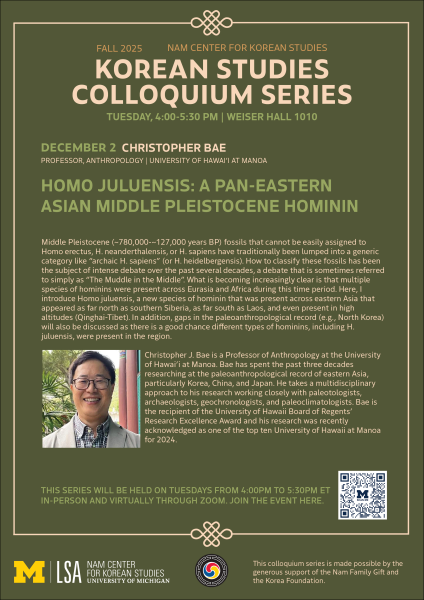Nam Center Colloquium Series | Homo juluensis: A Pan-Eastern Asian Middle Pleistocene Hominin
Christopher Bae, Professor, University of Hawai'i
Attend in person or via Zoom:
https://myumi.ch/w9kqG.
Middle Pleistocene (~780,000-~127,000 years BP) fossils that cannot be easily assigned to Homo erectus, H. neanderthalensis, or H. sapiens have traditionally been lumped into a generic category like “archaic H. sapiens” (or H. heidelbergensis). How to classify these fossils has been the subject of intense debate over the past several decades, a debate that is sometimes referred to simply as “The Muddle in the Middle." What is becoming increasingly clear is that multiple species of hominins were present across Eurasia and Africa during this time period. Here, Bae will introduce Homo juluensis, a new species of hominin that was present across eastern Asia that appeared as far north as southern Siberia, as far south as Laos, and even present in high altitudes (Qinghai-Tibet). In addition, gaps in the paleoanthropological record (e.g., North Korea) will also be discussed as there is a good chance different types of hominins, including H. juluensis, were present in the region.
Christopher J. Bae is a professor of anthropology at the University of Hawai’i at Manoa. Bae has spent the past three decades researching the paleoanthropological record of eastern Asia, particularly Korea, China, and Japan. He takes a multidisciplinary approach to his research working closely with paleontologists, archaeologists, geochronologists, and paleoclimatologists. Bae is the recipient of the University of Hawaii Board of Regents’ Research Excellence Award and his research was recently acknowledged as one of the top ten University of Hawaii at Manoa stories for 2024.
Article related to this talk: https://myumi.ch/n1gG3
If there is anything we can do to make this event accessible to you, please contact us at ncks.info@umich.edu. Please be aware that advance notice is necessary as some accommodations may require more time for the university to arrange.
Middle Pleistocene (~780,000-~127,000 years BP) fossils that cannot be easily assigned to Homo erectus, H. neanderthalensis, or H. sapiens have traditionally been lumped into a generic category like “archaic H. sapiens” (or H. heidelbergensis). How to classify these fossils has been the subject of intense debate over the past several decades, a debate that is sometimes referred to simply as “The Muddle in the Middle." What is becoming increasingly clear is that multiple species of hominins were present across Eurasia and Africa during this time period. Here, Bae will introduce Homo juluensis, a new species of hominin that was present across eastern Asia that appeared as far north as southern Siberia, as far south as Laos, and even present in high altitudes (Qinghai-Tibet). In addition, gaps in the paleoanthropological record (e.g., North Korea) will also be discussed as there is a good chance different types of hominins, including H. juluensis, were present in the region.
Christopher J. Bae is a professor of anthropology at the University of Hawai’i at Manoa. Bae has spent the past three decades researching the paleoanthropological record of eastern Asia, particularly Korea, China, and Japan. He takes a multidisciplinary approach to his research working closely with paleontologists, archaeologists, geochronologists, and paleoclimatologists. Bae is the recipient of the University of Hawaii Board of Regents’ Research Excellence Award and his research was recently acknowledged as one of the top ten University of Hawaii at Manoa stories for 2024.
Article related to this talk: https://myumi.ch/n1gG3
If there is anything we can do to make this event accessible to you, please contact us at ncks.info@umich.edu. Please be aware that advance notice is necessary as some accommodations may require more time for the university to arrange.
| Building: | Weiser Hall |
|---|---|
| Website: | |
| Event Type: | Lecture / Discussion |
| Tags: | Asian Languages And Cultures, History, Korea, Korean Studies |
| Source: | Happening @ Michigan from Nam Center for Korean Studies, International Institute, Asian Languages and Cultures |


